Sunday, 28. July 2013, 23:03 -
23:59, Ö1
A series of programs for Kunstradio devoted to Iberoamerican Radio Art
The works of this program are related to politics and society, basically Iberoamerican. However their authors, presenting each other few affinities in the procedures, and also belong to different generations and nationalities, have in common the interest in using sound with a political consciousness, taking its themes of society.
With "Argentina 78' remix", Fabián Racca builds a sort of bastard radio play that manipulates, through a turntable and a mixer with sampling, the vinyl of the radio transmissions of the matches of the Argentine World Cup of Football 1978 and music composed for the event. The election, far from being arbitrary, has a strong ideological charge.
Two aspects are related in “Oídos de Acero” (Ears of Steel), the work made by Zael Ortega in 2009 as a commission of Fonoteca Nacional of Mexico. On the one hand, this work is largely based on the hard, unyielding and stoic battle by the mexican social activist Salvador Zarco Flores (born 1944) against the deaf institutional dismantling of National Railways of Mexico. On the other hand, this work intends a measured evocation on the ideological and cultural explosion that happened in Mexico in 1910: the Mexican Revolution.
Concha Jerez and José Iges made a multiphonic work for the EES of the Museum of Contemporary Art (MUAC) of Mexico. Among other sounds, they used those from large public protest demonstrations that took place in 2012 in Madrid and Mexico City. Their "Sonic Cartography" continues their speech around the No-Mans Land as deregulated spaces or with a changeable regulation, that are in consequence also places for disorientation. And there is no doubt that the current crisis – not just in the economic sense- favors their expansion. This the World Premiere of the radio version.
The ecuadorian artist and organizer Fabiano Kueva made in 2002 his "Espejo de Sonido" ("Mirror of Sound") as an exercise of soundscape and critical geography developed as a radio broadcast satellite between the cities of Quito and Guayaquil. The sound contrast challenges the official discourse that antagonizes both cities and the work suffered censorship and should be suspended as installation.
1. Fabián Racca, AR: Argentina 78 remix -frgms-
2008, 13'
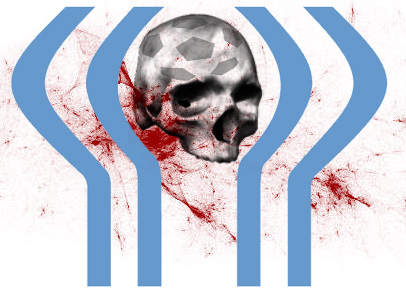
With Argentina 78' remix, Fabián Racca builds a sort of bastard radio play that manipulates, through a turntable and a mixer with sampling, the vinyl of the radio transmissions of the matches of the Argentine World Cup of Football 1978 and music composed for the event. The election, far from being arbitrary, has a strong ideological charge. Racca accentuates the nastier details of this traumatic episode in our history: the voice and the racist comments of the speaker José María Muñoz, emblematic character of the time, identified with the military dictatorship; Police sirens as a counterpoint to the triumph; a goal that the deformation through the mixer becomes a bitter lament by common graves; the catchy soundtrack of the Italian composer Enio Morricone modified into a kind of Elegy for the disappeared. The appeal to our memory is much more effective to the extent that Racca conforms exclusively to technologies of undoubted seventies mood - turntables, vinyl-, contemporary of the worst years of our lives.
2. Zael Ortega, MX:
Oídos de acero (Ears of Steel)
2009, 10'
The sense of sound creation does not lie in the creator's intention neither in the interpretation of the listener, but is based in the silence listening of the same sense, that is to say, in its openness and immanence. Thus, this organization of sounds, called “Oídos de Acero” (Ears of Steel), similarly seeks to be to the listening of a dual purpose. On the one hand, this work is largely based on the hard, unyielding and stoic battle by the mexican social activist Salvador Zarco Flores (born 1944) against the deaf institutional dismantling of National Railways of Mexico. On the other hand, this work intends a measured evocation on the ideological and cultural explosion that happened in Mexico in 1910 (Mexican Revolution), focusing especially to the Railway sound object and, more specifically, their honorable workers. In short, “Oídos de Acero” (Ears of Steel) is an open work that invites to think the Railway and to think from the Railway.
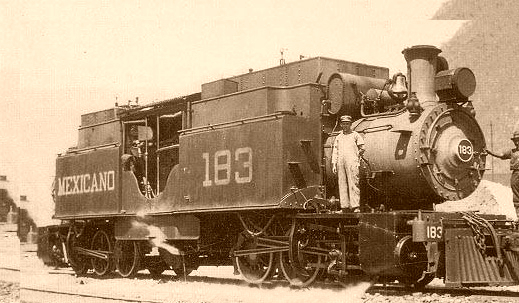
“Oídos de Acero” (Ears of Steel) is a work of Zael Ortega especially dedicated to Salvador Zarco Flores, a critical and responsible mexican social activist.
In 2009, Zael Ortega was commissioned by the National Sound Archive to create an intermedia work to celebrate the centenary of Mexican Revolution: “Oídos de Acero” (Ears of Steel), which recently took the first prize at the 8th International Biennial of Radio (2010). Also, this work has been presented as a sound installation at the own National Sound Archive; in the José Vasconcelos National Library; at the Railway Museum of Mexico City; in the Museum of Railways of Puebla City; at the “Discantus: Scenarios of the New Music” International Festival (2009 and 2010 Editions); and the “Puebla: Cradle of the Mexican Revolution” Festival (organized by the Institute of Arts and Culture of Puebla City). “Oídos de Acero” (Ears of Steel) also conform the sound design of a documentary produced and directed by the Railway Museum of Mexico City, on the rescue of two Steam Locomotives from 1901: the FCI-67 Locomotive and the NdeT-507 Locomotive. Moreover, “Oídos de Acero” (Ears of Steel) was performed live on the International Electroacoustic Music Festival “Spring in Havana 2010”, dedicated to celebrating the thirtieth anniversary of the National Laboratory of Electroacoustic Music, and the 45 years of the first public concert of Electroacoustic Music in Cuba, organized by composer Juan Blanco.
Commissioned and produced by Fonoteca Nacional de México.
3. Concha Jerez-José Iges, ES:
Tierras de nadie: Cartografía Sonora (No-Man's Land: Sound Cartography)
Coproduction ORF Kunstradio - MUAC EES / premiere stereo and 5.1 vers. 2012-2013, 15'
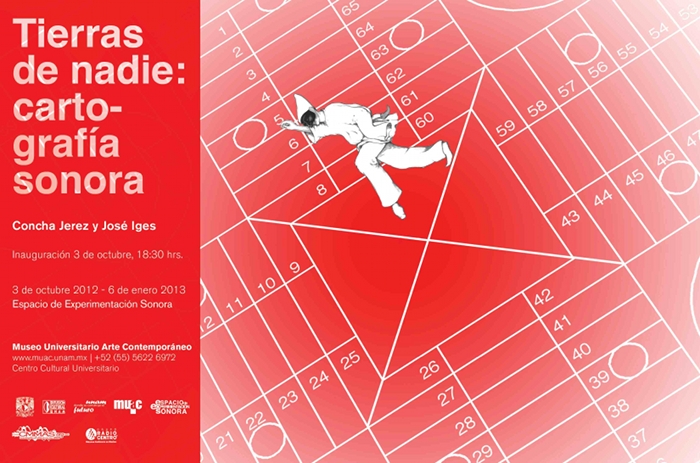
Tierras de nadie: Cartografía Sonora has as its origin the intermedia project Terre di nessuno (Tierras de nadie), carried out in Madrid in 2002, from which other subsequent installations have arisen, all of which employ audiovisual and informatic resources, as well as small radiophonic interferences. Having been invited to create a new work for the space of EES in the Museum MUAC (Mexico City), Concha Jerez and José Iges were interested in building not with those same materials, but with the very notions that underlie the aforementioned work.
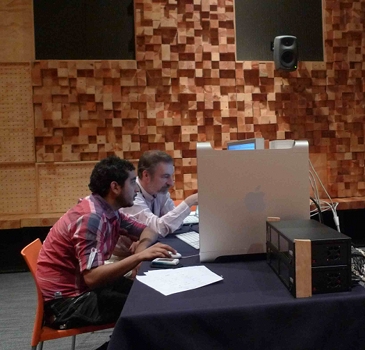
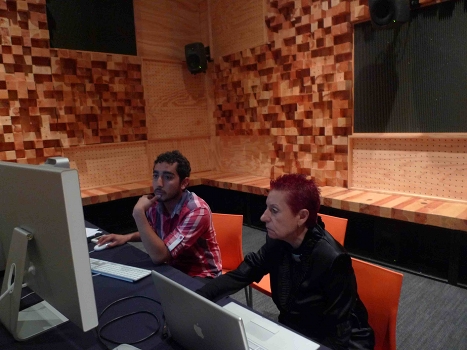
Iges and Jerez remind us that the theoretician and radiophonic producer Pinotto Fava asserted two decades ago that: “in the world in which we live in, the only possible lands are No-Man's Lands”. If those terre di nessuno are deregulated spaces or with a changeable regulation, they are in consequence also places for disorientation. And there is no doubt that the current crisis –not just in the economic sense- favors their expansion.
With this work, the artists propose an acoustic immersion into some of those No-Man’s Land which have been charted from the recordings of sonic actions carried out by themselves in many places.
Many, and nobody in particular, are also invited to partake in this journey through deconstructed landscapes; following, for example, a pulcinella who, coming from the Commedia dell'Arte reminds us that the world is one large theatre, from which we receive its sonic shadows in this place. He is the solitude of the long distance runner, of the tightrope walker with whom the artists also identify, wishing that our journey takes us nowhere…
Concha Jerez (Las Palmas de Gran Canaria, 1941) and José Iges (Madrid, 1951), have been working together since 1989, simultaneously with their respective individual work. Their practice, which in general they propose as Expanded Media with a special link to radio, is expressed as performances, concerts, installations, sculptures, videos and photomontages.
Since 1976, Concha Jerez centers her work, conceptual in its methodology, towards the development of in situ works and performances. In 2011 she received the Medalla de Oro al Mérito en las Bellas Artes bestowed by the Spanish Ministry of Culture.
José Iges has composed works for tape and digital supports, as well as for soloists accompanied by live or recorded electronics and for instrumental ensembles. His fundamental axis is the interaction between instruments as well as installation, multimedia art and the use of stagecraft and radiophonic language.
This composition was accomplished with the collaboration of Jorge Alberto Alba and the support of the Centro Mexicano para la Música y las Artes Sonoras (CMMAS), whom we thank for all their help.
Original recordings: Luc Ferrari, José Manuel Berenguer, Jessica Trejo, Hernán Risso Patrón, Concha Jerez and José Iges.
Percussion: Pilar Subirá
Commissioned by EES-MUAC, México. Stereo and 5.1 version produced by Kunstradio - Radiokunst (ORF).
4. Fabiano Kueva, ECU:
Doble Procesión (Double procession)
2000-2012, 11'
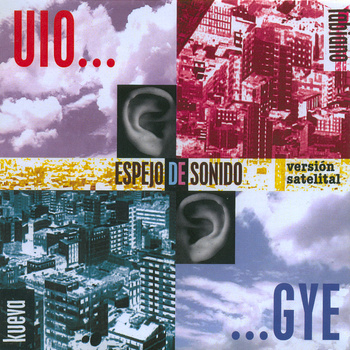
UIO-GYE: MIRROR OF SOUND
It is an exercise of soundscape and critical geography developed
between 2000 and 2002 in the cities of Quito (UIO) and Guayaquil (GYE), Ecuador.
Its thread conductor is the dialog and sound contrast
through games of discursive panning they challenge
the official discourse that antagonizes both cities.
Recorded in a minidisk system with hidden microphones,
Sound mirror is a journey through public spaces,
improvised conversations and media representations.
It was released in July 2002 simultaneously as a radio broadcast
satellite by system ALRED and a sound intervention on Malecon 2000 (GYE)
and Plaza Grande (UIO), spaces in which the work suffered censorship and should be suspended.
Mirror of Sound took part of the art event in the public sphere Ataque de Alas (Wings Attack) in the Antropological and Contemporary Art Museum of Guayaquil.
Doble Procesión is a representative fragment of Mirror of Sound.
[
DEUTSCH ]
KUNSTRADIO - RADIOKUNST
IBERWAVE SOCIOPOLITICAL LANDSCAPE
A series of programs for Kunstradio devoted to Iberoamerican Radio Art
curated by José Iges
|
Introductory Text
by José Iges
The works of this program are related to politics and society, basically Iberoamerican. However their authors, presenting each other few affinities in the procedures, and also belong to different generations and nationalities, have in common the interest in using sound with a political consciousness, taking its themes of society.
With "Argentina 78' remix", Fabián Racca builds a sort of bastard radio play that manipulates, through a turntable and a mixer with sampling, the vinyl of the radio transmissions of the matches of the Argentine World Cup of Football 1978 and music composed for the event. The election, far from being arbitrary, has a strong ideological charge.
Two aspects are related in “Oídos de Acero” (Ears of Steel), the work made by Zael Ortega in 2009 as a commission of Fonoteca Nacional of Mexico. On the one hand, this work is largely based on the hard, unyielding and stoic battle by the mexican social activist Salvador Zarco Flores (born 1944) against the deaf institutional dismantling of National Railways of Mexico. On the other hand, this work intends a measured evocation on the ideological and cultural explosion that happened in Mexico in 1910: the Mexican Revolution.
Concha Jerez and José Iges made a multiphonic work for the EES of the Museum of Contemporary Art (MUAC) of Mexico. Among other sounds, they used those from large public protest demonstrations that took place in 2012 in Madrid and Mexico City. Their "Sonic Cartography" continues their speech around the No-Mans Land as deregulated spaces or with a changeable regulation, that are in consequence also places for disorientation. And there is no doubt that the current crisis – not just in the economic sense- favors their expansion. This the World Premiere of the radio version.
The ecuadorian artist and organizer Fabiano Kueva made in 2002 his "Espejo de Sonido" ("Mirror of Sound") as an exercise of soundscape and critical geography developed as a radio broadcast satellite between the cities of Quito and Guayaquil. The sound contrast challenges the official discourse that antagonizes both cities and the work suffered censorship and should be suspended as installation.
1. Fabián Racca, AR: Argentina 78 remix -frgms-
2008, 13'

- El viento cruza la cancha (The wind crosses the Court) 7'40"
 PLAY
PLAY
-
Después de tantas cosas que se dijeron (After
so many things that are said) 3'15"
 PLAY
PLAY
-
Nuestro corazón (Our Heart) 2'12"
 PLAY
PLAY
F. Racca
With Argentina 78' remix, Fabián Racca builds a sort of bastard radio play that manipulates, through a turntable and a mixer with sampling, the vinyl of the radio transmissions of the matches of the Argentine World Cup of Football 1978 and music composed for the event. The election, far from being arbitrary, has a strong ideological charge. Racca accentuates the nastier details of this traumatic episode in our history: the voice and the racist comments of the speaker José María Muñoz, emblematic character of the time, identified with the military dictatorship; Police sirens as a counterpoint to the triumph; a goal that the deformation through the mixer becomes a bitter lament by common graves; the catchy soundtrack of the Italian composer Enio Morricone modified into a kind of Elegy for the disappeared. The appeal to our memory is much more effective to the extent that Racca conforms exclusively to technologies of undoubted seventies mood - turntables, vinyl-, contemporary of the worst years of our lives.
2. Zael Ortega, MX:
Oídos de acero (Ears of Steel)
2009, 10'
 PLAY
PLAY
The sense of sound creation does not lie in the creator's intention neither in the interpretation of the listener, but is based in the silence listening of the same sense, that is to say, in its openness and immanence. Thus, this organization of sounds, called “Oídos de Acero” (Ears of Steel), similarly seeks to be to the listening of a dual purpose. On the one hand, this work is largely based on the hard, unyielding and stoic battle by the mexican social activist Salvador Zarco Flores (born 1944) against the deaf institutional dismantling of National Railways of Mexico. On the other hand, this work intends a measured evocation on the ideological and cultural explosion that happened in Mexico in 1910 (Mexican Revolution), focusing especially to the Railway sound object and, more specifically, their honorable workers. In short, “Oídos de Acero” (Ears of Steel) is an open work that invites to think the Railway and to think from the Railway.

“Oídos de Acero” (Ears of Steel) is a work of Zael Ortega especially dedicated to Salvador Zarco Flores, a critical and responsible mexican social activist.
In 2009, Zael Ortega was commissioned by the National Sound Archive to create an intermedia work to celebrate the centenary of Mexican Revolution: “Oídos de Acero” (Ears of Steel), which recently took the first prize at the 8th International Biennial of Radio (2010). Also, this work has been presented as a sound installation at the own National Sound Archive; in the José Vasconcelos National Library; at the Railway Museum of Mexico City; in the Museum of Railways of Puebla City; at the “Discantus: Scenarios of the New Music” International Festival (2009 and 2010 Editions); and the “Puebla: Cradle of the Mexican Revolution” Festival (organized by the Institute of Arts and Culture of Puebla City). “Oídos de Acero” (Ears of Steel) also conform the sound design of a documentary produced and directed by the Railway Museum of Mexico City, on the rescue of two Steam Locomotives from 1901: the FCI-67 Locomotive and the NdeT-507 Locomotive. Moreover, “Oídos de Acero” (Ears of Steel) was performed live on the International Electroacoustic Music Festival “Spring in Havana 2010”, dedicated to celebrating the thirtieth anniversary of the National Laboratory of Electroacoustic Music, and the 45 years of the first public concert of Electroacoustic Music in Cuba, organized by composer Juan Blanco.
Commissioned and produced by Fonoteca Nacional de México.
3. Concha Jerez-José Iges, ES:
Tierras de nadie: Cartografía Sonora (No-Man's Land: Sound Cartography)
Coproduction ORF Kunstradio - MUAC EES / premiere stereo and 5.1 vers. 2012-2013, 15'
 PLAY
PLAY

Tierras de nadie: Cartografía Sonora has as its origin the intermedia project Terre di nessuno (Tierras de nadie), carried out in Madrid in 2002, from which other subsequent installations have arisen, all of which employ audiovisual and informatic resources, as well as small radiophonic interferences. Having been invited to create a new work for the space of EES in the Museum MUAC (Mexico City), Concha Jerez and José Iges were interested in building not with those same materials, but with the very notions that underlie the aforementioned work.


Iges and Jerez remind us that the theoretician and radiophonic producer Pinotto Fava asserted two decades ago that: “in the world in which we live in, the only possible lands are No-Man's Lands”. If those terre di nessuno are deregulated spaces or with a changeable regulation, they are in consequence also places for disorientation. And there is no doubt that the current crisis –not just in the economic sense- favors their expansion.
With this work, the artists propose an acoustic immersion into some of those No-Man’s Land which have been charted from the recordings of sonic actions carried out by themselves in many places.
Many, and nobody in particular, are also invited to partake in this journey through deconstructed landscapes; following, for example, a pulcinella who, coming from the Commedia dell'Arte reminds us that the world is one large theatre, from which we receive its sonic shadows in this place. He is the solitude of the long distance runner, of the tightrope walker with whom the artists also identify, wishing that our journey takes us nowhere…
Concha Jerez (Las Palmas de Gran Canaria, 1941) and José Iges (Madrid, 1951), have been working together since 1989, simultaneously with their respective individual work. Their practice, which in general they propose as Expanded Media with a special link to radio, is expressed as performances, concerts, installations, sculptures, videos and photomontages.
Since 1976, Concha Jerez centers her work, conceptual in its methodology, towards the development of in situ works and performances. In 2011 she received the Medalla de Oro al Mérito en las Bellas Artes bestowed by the Spanish Ministry of Culture.
José Iges has composed works for tape and digital supports, as well as for soloists accompanied by live or recorded electronics and for instrumental ensembles. His fundamental axis is the interaction between instruments as well as installation, multimedia art and the use of stagecraft and radiophonic language.
This composition was accomplished with the collaboration of Jorge Alberto Alba and the support of the Centro Mexicano para la Música y las Artes Sonoras (CMMAS), whom we thank for all their help.
Original recordings: Luc Ferrari, José Manuel Berenguer, Jessica Trejo, Hernán Risso Patrón, Concha Jerez and José Iges.
Percussion: Pilar Subirá
Commissioned by EES-MUAC, México. Stereo and 5.1 version produced by Kunstradio - Radiokunst (ORF).
4. Fabiano Kueva, ECU:
Doble Procesión (Double procession)
2000-2012, 11'
 PLAY
PLAY

UIO-GYE: MIRROR OF SOUND
It is an exercise of soundscape and critical geography developed
between 2000 and 2002 in the cities of Quito (UIO) and Guayaquil (GYE), Ecuador.
Its thread conductor is the dialog and sound contrast
through games of discursive panning they challenge
the official discourse that antagonizes both cities.
Recorded in a minidisk system with hidden microphones,
Sound mirror is a journey through public spaces,
improvised conversations and media representations.
It was released in July 2002 simultaneously as a radio broadcast
satellite by system ALRED and a sound intervention on Malecon 2000 (GYE)
and Plaza Grande (UIO), spaces in which the work suffered censorship and should be suspended.
Mirror of Sound took part of the art event in the public sphere Ataque de Alas (Wings Attack) in the Antropological and Contemporary Art Museum of Guayaquil.
Doble Procesión is a representative fragment of Mirror of Sound.